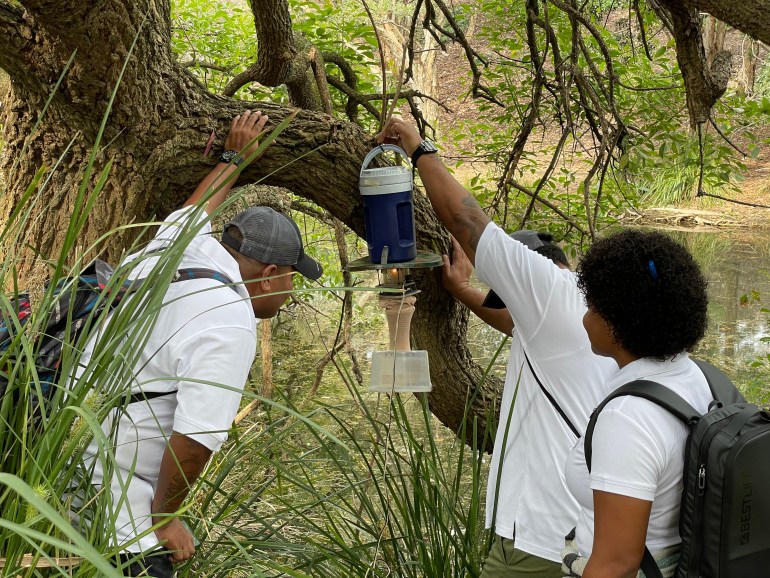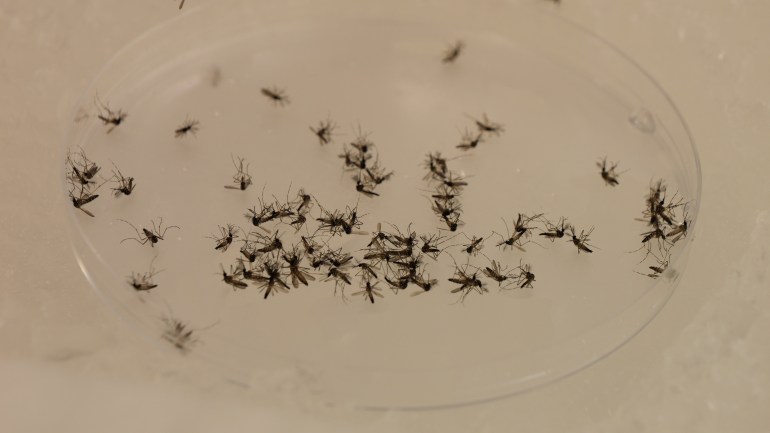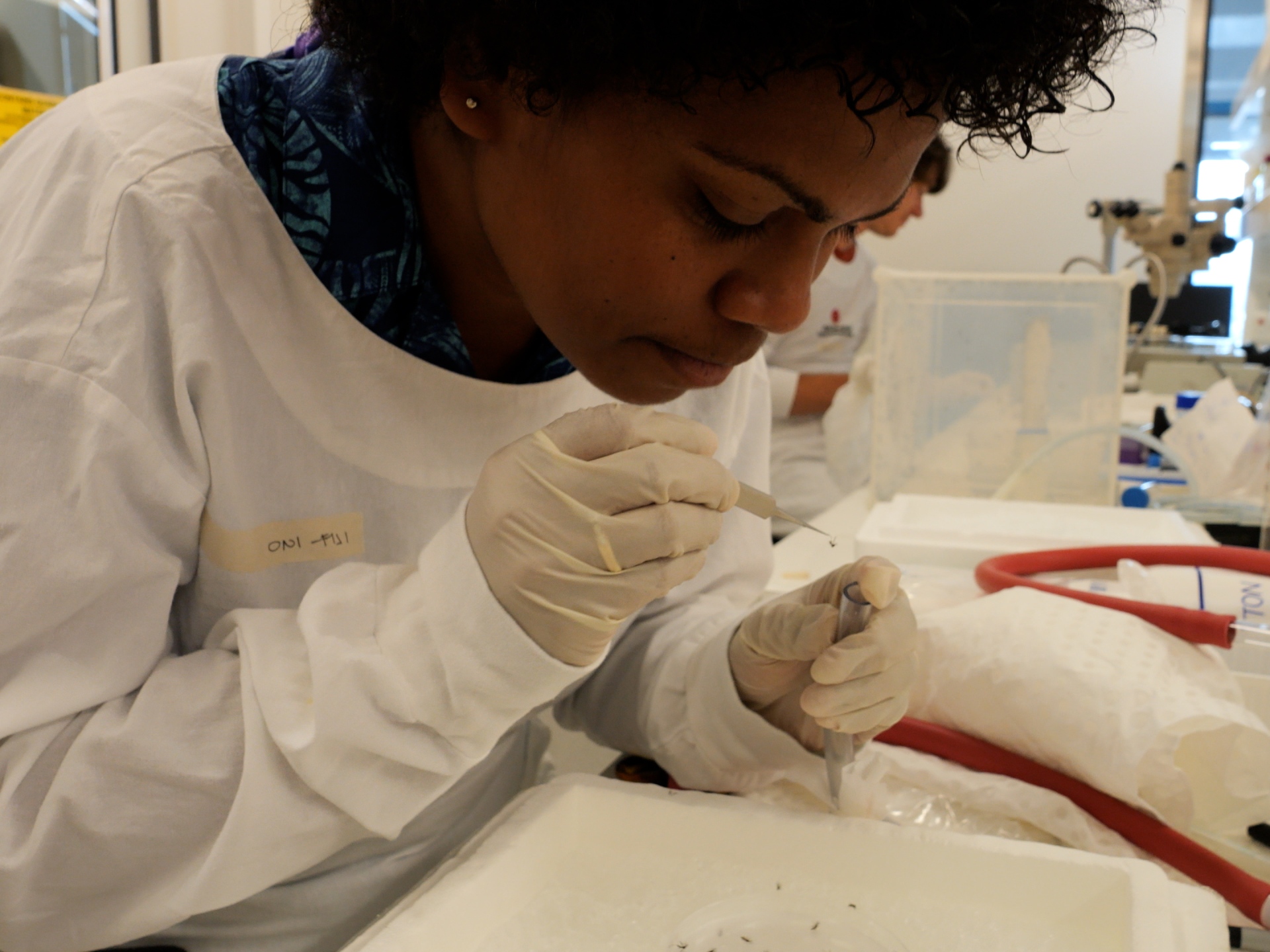Climate change forecasters have warned for years that the warmer and wetter world created by the climate crisis will drive a surge in mosquito-borne diseases, such as malaria and dengue fever.
Experts say that in the Pacific Islands, such predictions are now becoming a reality.
The regional development organisation, the Pacific Community, says between 2012 and 2021, its Pacific island members recorded 69 outbreaks of dengue fever, 12 outbreaks of Zika virus and 15 of Chikungunya virus. The diseases, which can sometimes be fatal, are all transmitted by mosquitoes that thrive in warm, humid conditions.
Disease surveillance by the World Health Organization shows that in the Solomon Islands, for instance, malaria cases rose by 40 percent between 2015 and 2021. Papua New Guinea saw incidences of malaria rise by 5 percent over the same period, with a 25 percent increase in related deaths.
“We are really concerned about vector-borne diseases, mainly because they are a serious public health problem. Dengue fever is of increasing concern because it can lead to dengue haemorrhagic fever, which can lead to death. Also, Zika has recently emerged and there is evidence that it can cause congenital defects in babies,” Dr Salanieta Saketa, a senior epidemiologist in the Pacific Community’s public health division in Fiji, told Al Jazeera.
Zika, which causes a rash, fever, headache, muscle and joint pain, Chikungunya, which causes debilitating joint pain, and dengue are transmitted by the Aedes aegypti mosquito which tends to bite during the day.
“Climate change is an important factor. It has already been proven that vector-borne diseases are very climate sensitive diseases. This is what we can see in the region; they emerge after disasters, cyclones and when there is a rise in temperatures,” Saketa said.

Taking action now is crucial, according to Tom Burkot, a professor at the Institute of Tropical Health and Medicine at Australia’s James Cook University in Cairns.
“If we just maintain the status quo, outbreaks of vector-borne diseases in the Pacific will likely get more frequent and larger in number. To prevent this from happening, we need to invest in new strategies to control the mosquito[s] and to treat or prevent infections in humans,” Burkot, who is leading an international partnership between Pacific Island countries and health and research institutions to find new ways of combatting these diseases, told Al Jazeera.
Vector-borne diseases occur when people are infected by parasites or viruses carried by vectors, which are commonly mosquitoes and other blood-sucking insects, and are most prevalent in tropical and sub-tropical parts of the world where the warm climate provides the ideal conditions for them to thrive.
In PNG, located east of Indonesia and north of Australia in the southern Pacific, the average temperature hovers around 25C (77 F) all year and humidity ranges from 70 to 90 percent.
Vector-borne diseases are “a significant public health problem in coastal PNG. Malaria is the leading vector-borne disease of concern; over 87 percent of the malaria burden in the Western Pacific region is from PNG,” Dr Moses Laman, deputy director for science at PNG’s Institute of Medical Research in the country’s Eastern Highlands Province, told Al Jazeera.
“Malaria was declining in PNG until about 2014-2015. But field-based epidemiological studies and monitoring and evaluation of the national malaria control programme by the institute has shown a resurgence of malaria after that period,” he added.
Key factors in this resurgence include insufficient disease surveillance in the country and a lack of resources and capacity in the health system to respond effectively.
‘Highly adapted’
Dengue fever is also fast becoming a significant worry.
Without an effective vaccine or dedicated treatment, the fever has gained ground in densely-populated urban areas, not only in the Pacific Islands but warmer parts of the world in recent decades, according to the WHO.
Dengue can cause a wide range of illnesses and complications – from severe flu-like symptoms to excruciating abdominal pain, vomiting, chronic bleeding, breathing difficulties and organ damage.
“In the Pacific, malaria is endemic in only three countries, whereas diseases like dengue and Zika can potentially be transmitted in every Pacific Island country.
“The Aedes vectors of dengue are highly adapted to human environments, so the potential for outbreaks is linked to urban areas, as [they] feed almost exclusively on humans and their larvae are predominantly found in man-made containers,” James Cook University’s Burkot explained.

The Solomon Islands, a sprawling archipelago of more than 900 islands southeast of PNG, has experienced a number of dengue outbreaks in recent years.
A large outbreak in the capital Honiara in 2013 affected nearly 2,000 people. It followed the heavy rains of the wet season and an earthquake and tsunami, which devastated parts of the country that February. Three years later, there was an even larger dengue outbreak, affecting more than 12,000 people. Of those, some 877 patients needed hospital treatment and 16 people died.
Malaria is common in rural villages of the country’s outer islands, such as those in Isabel Province, especially during the wet season from November to April.
“We are having cases of mosquito-borne diseases – especially at this time, it is on the rise. It is quite a threat. The mosquitoes live around the village, near ponds and open drainage – that is where they breed,” Rhoda Sikilabu, the premier of Isabel Province, told Al Jazeera.
“There have been very high cases of malaria in my village of Horara. I have experienced malaria three times since last year,” she recounted.
The climate crisis is creating ever more favourable conditions for disease-carrying mosquitoes.
During the coming decades, Pacific Island nations will experience higher air temperatures and more extreme heatwaves and rainfall, according to the sixth assessment of the Intergovernmental Panel on Climate Change released in February last year. Other factors, such as resistance to insecticide, population growth and increasing numbers of people travelling will also influence the rise of cases.
Burkot says many Pacific Island countries do not have enough human and financial resources to fight the rise in disease so the collaborative PacMOSSI project, which brings together Pacific Island countries and institutions – including the WHO, Pacific Community, QIMR Berghofer Medical Research Institute and James Cook University – is working to address the challenge.
It plans to boost training of health workers across the region, support the health capacity of governments and work with local communities on the control of mosquito-affected areas.
Prevention is vital, given the lack of effective vaccines (the new malaria vaccine is not yet available in the Pacific region). In PNG, “the mainstay of prevention of vector-borne diseases is through long-lasting insecticide-treated bed nets. These are provided throughout the country every two to three years by the national department of health and Rotarians Against Malaria,” Dr Laman said.
However, he added that, in recent years, studies of bed nets in use in PNG had revealed issues with their quality and ability to screen mosquitoes. As a result, the country was now procuring higher quality nets, which met the standards of the WHO, from new sources.

Reducing the presence and threat of mosquitoes is a key goal of the work being done by the Pacific Community and the PacMOSSI project.
This means helping countries to improve “mosquito surveys, to find out what type of mosquitoes they have and their distribution, and if there has been any foreign introduction of other mosquitoes in the region,” Dr Saketa said.
“One of the key ways of controlling mosquitoes is to remove breeding sites, to clean up and destroy the breeding areas.”
